Final Accounts: Preparation for Sole Traders and Partnerships
VerifiedAdded on 2020/12/18
|17
|4244
|309
Report
AI Summary
This report delves into the preparation and analysis of final accounts for sole traders and partnerships. It begins with the reasons for closing off accounts and producing a trial balance, discussing the processes and limitations of preparing final accounts, and exploring methods of constructing accounts from incomplete records. The report then covers the calculation of opening and closing capital, as well as opening and closing cash/bank accounts, alongside the preparation of sales and purchase ledger control accounts, and the concepts of markups and margins. It further elaborates on the components of final accounts, including the statement of profit and loss and the statement of financial position. The report extends to partnership accounts, outlining key components of partnership agreements and accounts, the statement of profit and loss appropriation account, and the allocation of profit to partners, including capital and current accounts. Finally, it addresses the calculation of closing balances for each partner's capital and current account and the construction of the statement of financial position. The report concludes with a comprehensive overview of the key aspects of final account preparation and analysis for both sole traders and partnerships.

Prepare final accounts for sole
traders and partnerships
traders and partnerships
Paraphrase This Document
Need a fresh take? Get an instant paraphrase of this document with our AI Paraphraser
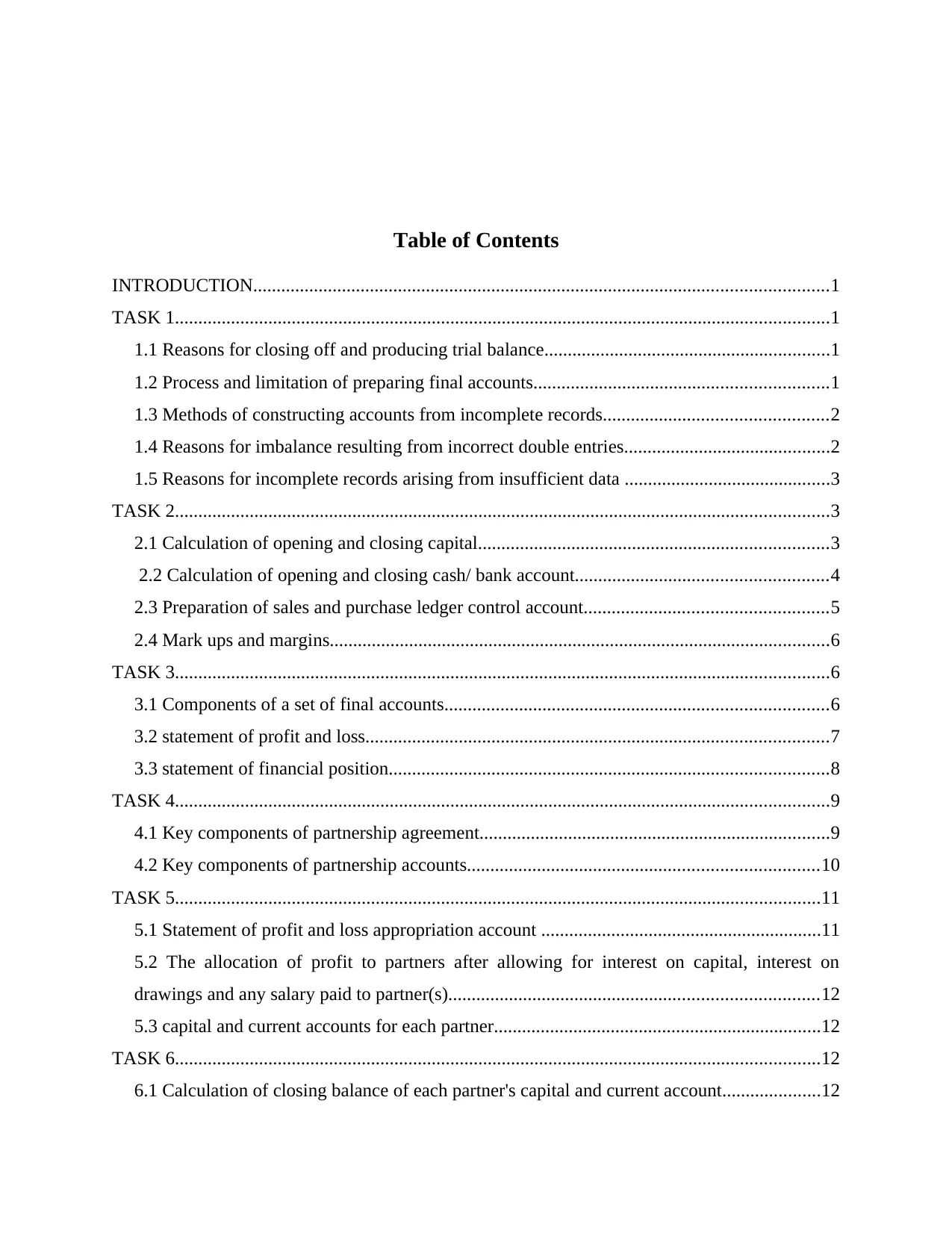
Table of Contents
INTRODUCTION...........................................................................................................................1
TASK 1............................................................................................................................................1
1.1 Reasons for closing off and producing trial balance.............................................................1
1.2 Process and limitation of preparing final accounts...............................................................1
1.3 Methods of constructing accounts from incomplete records................................................2
1.4 Reasons for imbalance resulting from incorrect double entries............................................2
1.5 Reasons for incomplete records arising from insufficient data ............................................3
TASK 2............................................................................................................................................3
2.1 Calculation of opening and closing capital...........................................................................3
2.2 Calculation of opening and closing cash/ bank account......................................................4
2.3 Preparation of sales and purchase ledger control account....................................................5
2.4 Mark ups and margins...........................................................................................................6
TASK 3............................................................................................................................................6
3.1 Components of a set of final accounts..................................................................................6
3.2 statement of profit and loss...................................................................................................7
3.3 statement of financial position..............................................................................................8
TASK 4............................................................................................................................................9
4.1 Key components of partnership agreement...........................................................................9
4.2 Key components of partnership accounts...........................................................................10
TASK 5..........................................................................................................................................11
5.1 Statement of profit and loss appropriation account ............................................................11
5.2 The allocation of profit to partners after allowing for interest on capital, interest on
drawings and any salary paid to partner(s)...............................................................................12
5.3 capital and current accounts for each partner......................................................................12
TASK 6..........................................................................................................................................12
6.1 Calculation of closing balance of each partner's capital and current account.....................12
INTRODUCTION...........................................................................................................................1
TASK 1............................................................................................................................................1
1.1 Reasons for closing off and producing trial balance.............................................................1
1.2 Process and limitation of preparing final accounts...............................................................1
1.3 Methods of constructing accounts from incomplete records................................................2
1.4 Reasons for imbalance resulting from incorrect double entries............................................2
1.5 Reasons for incomplete records arising from insufficient data ............................................3
TASK 2............................................................................................................................................3
2.1 Calculation of opening and closing capital...........................................................................3
2.2 Calculation of opening and closing cash/ bank account......................................................4
2.3 Preparation of sales and purchase ledger control account....................................................5
2.4 Mark ups and margins...........................................................................................................6
TASK 3............................................................................................................................................6
3.1 Components of a set of final accounts..................................................................................6
3.2 statement of profit and loss...................................................................................................7
3.3 statement of financial position..............................................................................................8
TASK 4............................................................................................................................................9
4.1 Key components of partnership agreement...........................................................................9
4.2 Key components of partnership accounts...........................................................................10
TASK 5..........................................................................................................................................11
5.1 Statement of profit and loss appropriation account ............................................................11
5.2 The allocation of profit to partners after allowing for interest on capital, interest on
drawings and any salary paid to partner(s)...............................................................................12
5.3 capital and current accounts for each partner......................................................................12
TASK 6..........................................................................................................................................12
6.1 Calculation of closing balance of each partner's capital and current account.....................12
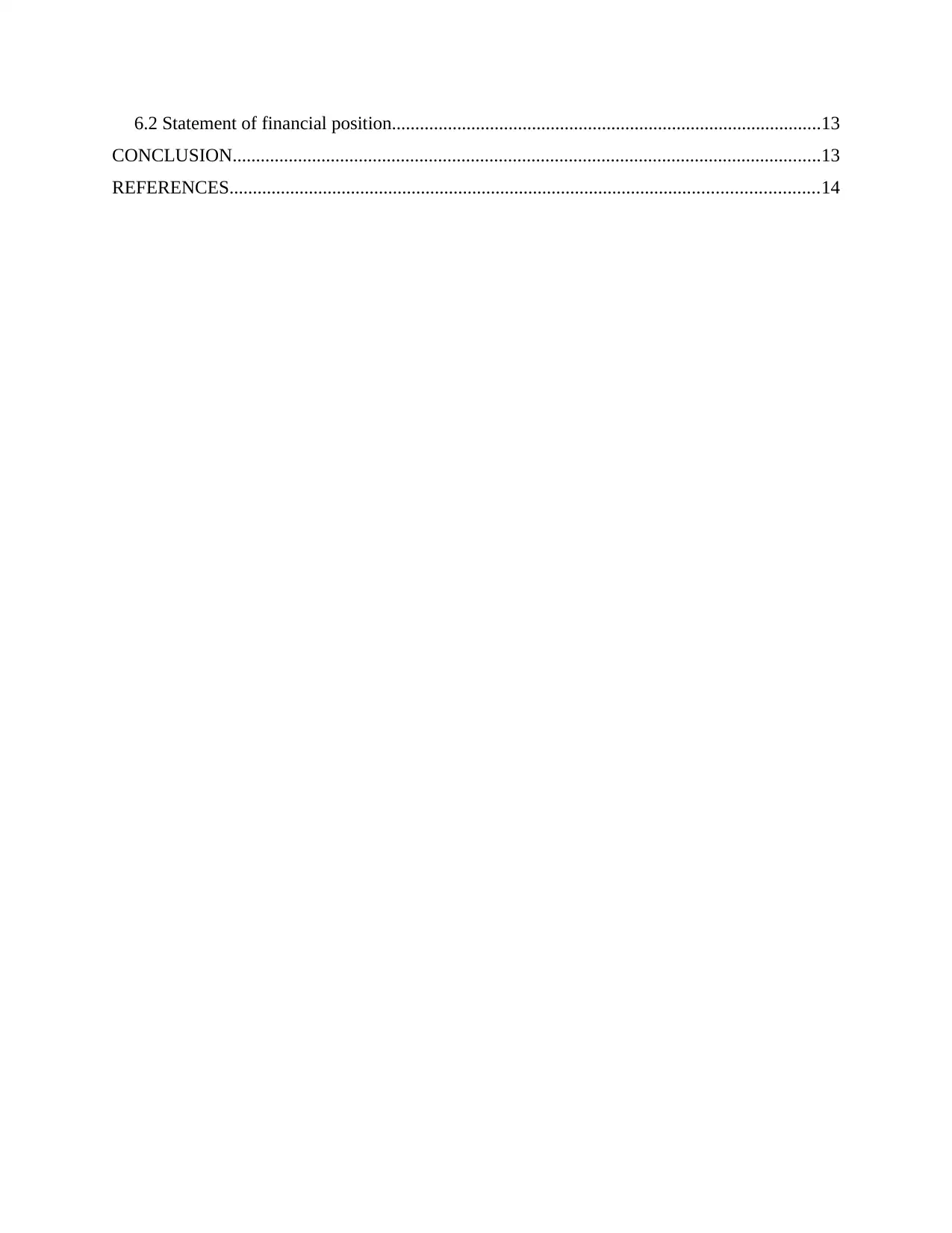
6.2 Statement of financial position............................................................................................13
CONCLUSION..............................................................................................................................13
REFERENCES..............................................................................................................................14
CONCLUSION..............................................................................................................................13
REFERENCES..............................................................................................................................14
⊘ This is a preview!⊘
Do you want full access?
Subscribe today to unlock all pages.

Trusted by 1+ million students worldwide
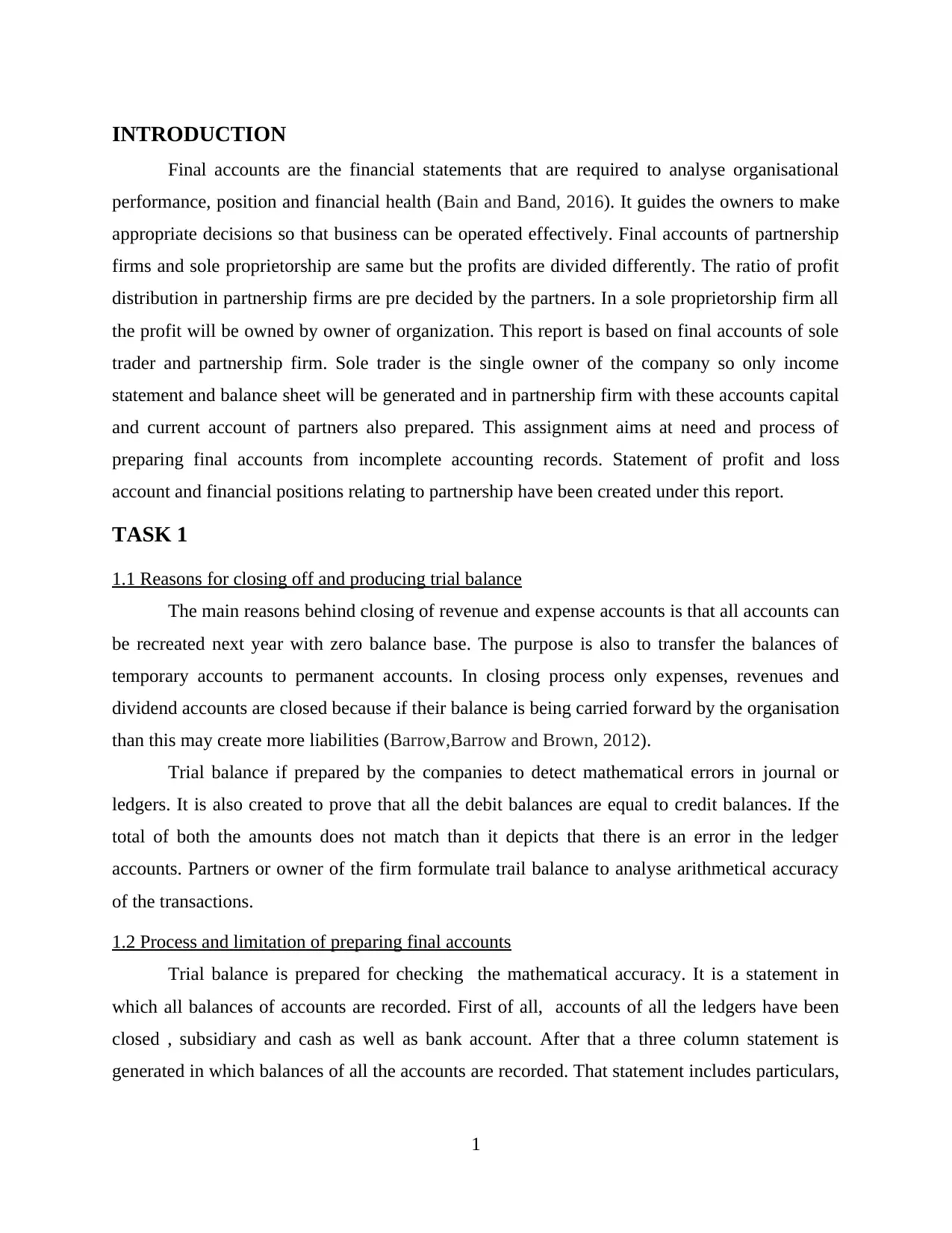
INTRODUCTION
Final accounts are the financial statements that are required to analyse organisational
performance, position and financial health (Bain and Band, 2016). It guides the owners to make
appropriate decisions so that business can be operated effectively. Final accounts of partnership
firms and sole proprietorship are same but the profits are divided differently. The ratio of profit
distribution in partnership firms are pre decided by the partners. In a sole proprietorship firm all
the profit will be owned by owner of organization. This report is based on final accounts of sole
trader and partnership firm. Sole trader is the single owner of the company so only income
statement and balance sheet will be generated and in partnership firm with these accounts capital
and current account of partners also prepared. This assignment aims at need and process of
preparing final accounts from incomplete accounting records. Statement of profit and loss
account and financial positions relating to partnership have been created under this report.
TASK 1
1.1 Reasons for closing off and producing trial balance
The main reasons behind closing of revenue and expense accounts is that all accounts can
be recreated next year with zero balance base. The purpose is also to transfer the balances of
temporary accounts to permanent accounts. In closing process only expenses, revenues and
dividend accounts are closed because if their balance is being carried forward by the organisation
than this may create more liabilities (Barrow,Barrow and Brown, 2012).
Trial balance if prepared by the companies to detect mathematical errors in journal or
ledgers. It is also created to prove that all the debit balances are equal to credit balances. If the
total of both the amounts does not match than it depicts that there is an error in the ledger
accounts. Partners or owner of the firm formulate trail balance to analyse arithmetical accuracy
of the transactions.
1.2 Process and limitation of preparing final accounts
Trial balance is prepared for checking the mathematical accuracy. It is a statement in
which all balances of accounts are recorded. First of all, accounts of all the ledgers have been
closed , subsidiary and cash as well as bank account. After that a three column statement is
generated in which balances of all the accounts are recorded. That statement includes particulars,
1
Final accounts are the financial statements that are required to analyse organisational
performance, position and financial health (Bain and Band, 2016). It guides the owners to make
appropriate decisions so that business can be operated effectively. Final accounts of partnership
firms and sole proprietorship are same but the profits are divided differently. The ratio of profit
distribution in partnership firms are pre decided by the partners. In a sole proprietorship firm all
the profit will be owned by owner of organization. This report is based on final accounts of sole
trader and partnership firm. Sole trader is the single owner of the company so only income
statement and balance sheet will be generated and in partnership firm with these accounts capital
and current account of partners also prepared. This assignment aims at need and process of
preparing final accounts from incomplete accounting records. Statement of profit and loss
account and financial positions relating to partnership have been created under this report.
TASK 1
1.1 Reasons for closing off and producing trial balance
The main reasons behind closing of revenue and expense accounts is that all accounts can
be recreated next year with zero balance base. The purpose is also to transfer the balances of
temporary accounts to permanent accounts. In closing process only expenses, revenues and
dividend accounts are closed because if their balance is being carried forward by the organisation
than this may create more liabilities (Barrow,Barrow and Brown, 2012).
Trial balance if prepared by the companies to detect mathematical errors in journal or
ledgers. It is also created to prove that all the debit balances are equal to credit balances. If the
total of both the amounts does not match than it depicts that there is an error in the ledger
accounts. Partners or owner of the firm formulate trail balance to analyse arithmetical accuracy
of the transactions.
1.2 Process and limitation of preparing final accounts
Trial balance is prepared for checking the mathematical accuracy. It is a statement in
which all balances of accounts are recorded. First of all, accounts of all the ledgers have been
closed , subsidiary and cash as well as bank account. After that a three column statement is
generated in which balances of all the accounts are recorded. That statement includes particulars,
1
Paraphrase This Document
Need a fresh take? Get an instant paraphrase of this document with our AI Paraphraser
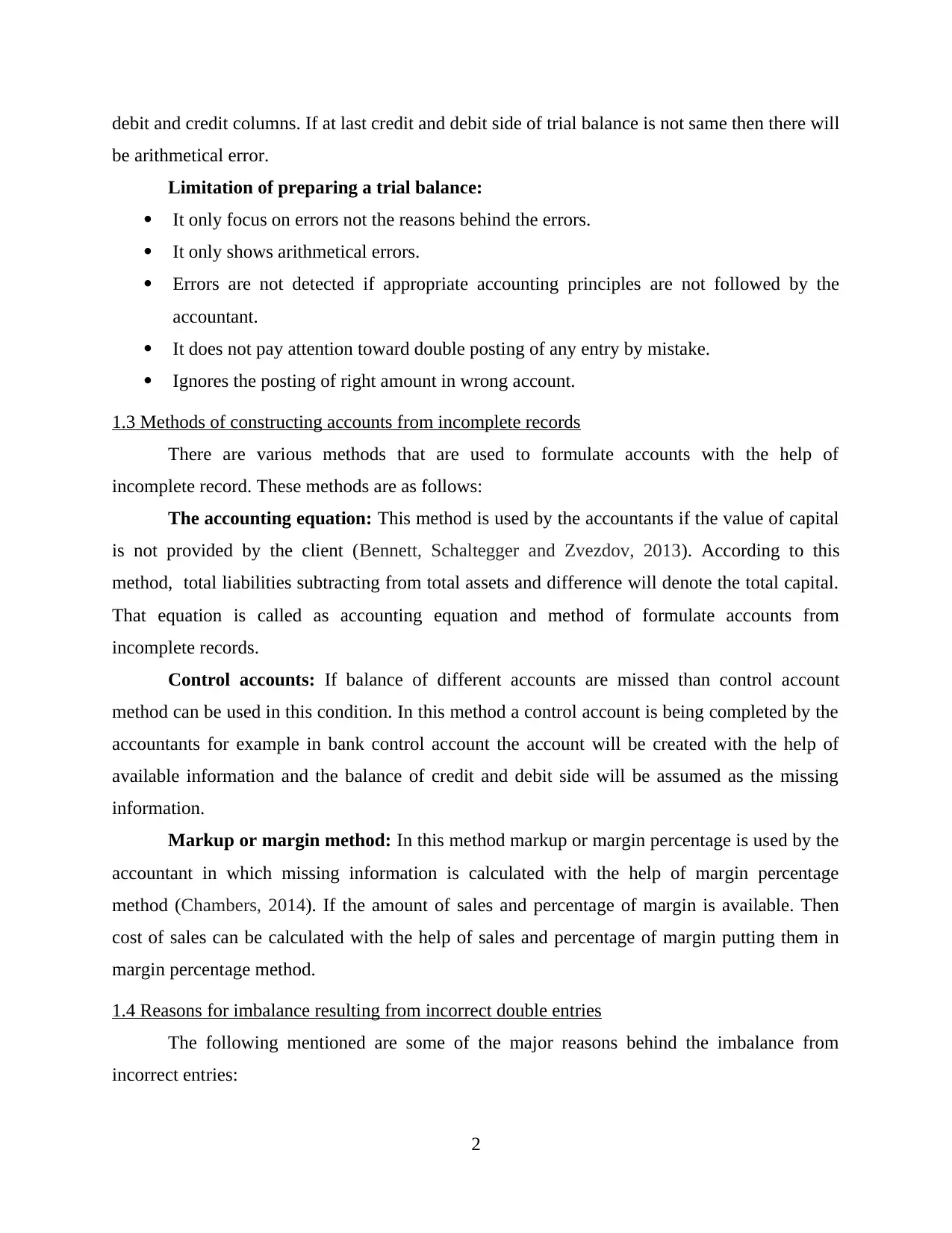
debit and credit columns. If at last credit and debit side of trial balance is not same then there will
be arithmetical error.
Limitation of preparing a trial balance:
It only focus on errors not the reasons behind the errors.
It only shows arithmetical errors.
Errors are not detected if appropriate accounting principles are not followed by the
accountant.
It does not pay attention toward double posting of any entry by mistake.
Ignores the posting of right amount in wrong account.
1.3 Methods of constructing accounts from incomplete records
There are various methods that are used to formulate accounts with the help of
incomplete record. These methods are as follows:
The accounting equation: This method is used by the accountants if the value of capital
is not provided by the client (Bennett, Schaltegger and Zvezdov, 2013). According to this
method, total liabilities subtracting from total assets and difference will denote the total capital.
That equation is called as accounting equation and method of formulate accounts from
incomplete records.
Control accounts: If balance of different accounts are missed than control account
method can be used in this condition. In this method a control account is being completed by the
accountants for example in bank control account the account will be created with the help of
available information and the balance of credit and debit side will be assumed as the missing
information.
Markup or margin method: In this method markup or margin percentage is used by the
accountant in which missing information is calculated with the help of margin percentage
method (Chambers, 2014). If the amount of sales and percentage of margin is available. Then
cost of sales can be calculated with the help of sales and percentage of margin putting them in
margin percentage method.
1.4 Reasons for imbalance resulting from incorrect double entries
The following mentioned are some of the major reasons behind the imbalance from
incorrect entries:
2
be arithmetical error.
Limitation of preparing a trial balance:
It only focus on errors not the reasons behind the errors.
It only shows arithmetical errors.
Errors are not detected if appropriate accounting principles are not followed by the
accountant.
It does not pay attention toward double posting of any entry by mistake.
Ignores the posting of right amount in wrong account.
1.3 Methods of constructing accounts from incomplete records
There are various methods that are used to formulate accounts with the help of
incomplete record. These methods are as follows:
The accounting equation: This method is used by the accountants if the value of capital
is not provided by the client (Bennett, Schaltegger and Zvezdov, 2013). According to this
method, total liabilities subtracting from total assets and difference will denote the total capital.
That equation is called as accounting equation and method of formulate accounts from
incomplete records.
Control accounts: If balance of different accounts are missed than control account
method can be used in this condition. In this method a control account is being completed by the
accountants for example in bank control account the account will be created with the help of
available information and the balance of credit and debit side will be assumed as the missing
information.
Markup or margin method: In this method markup or margin percentage is used by the
accountant in which missing information is calculated with the help of margin percentage
method (Chambers, 2014). If the amount of sales and percentage of margin is available. Then
cost of sales can be calculated with the help of sales and percentage of margin putting them in
margin percentage method.
1.4 Reasons for imbalance resulting from incorrect double entries
The following mentioned are some of the major reasons behind the imbalance from
incorrect entries:
2
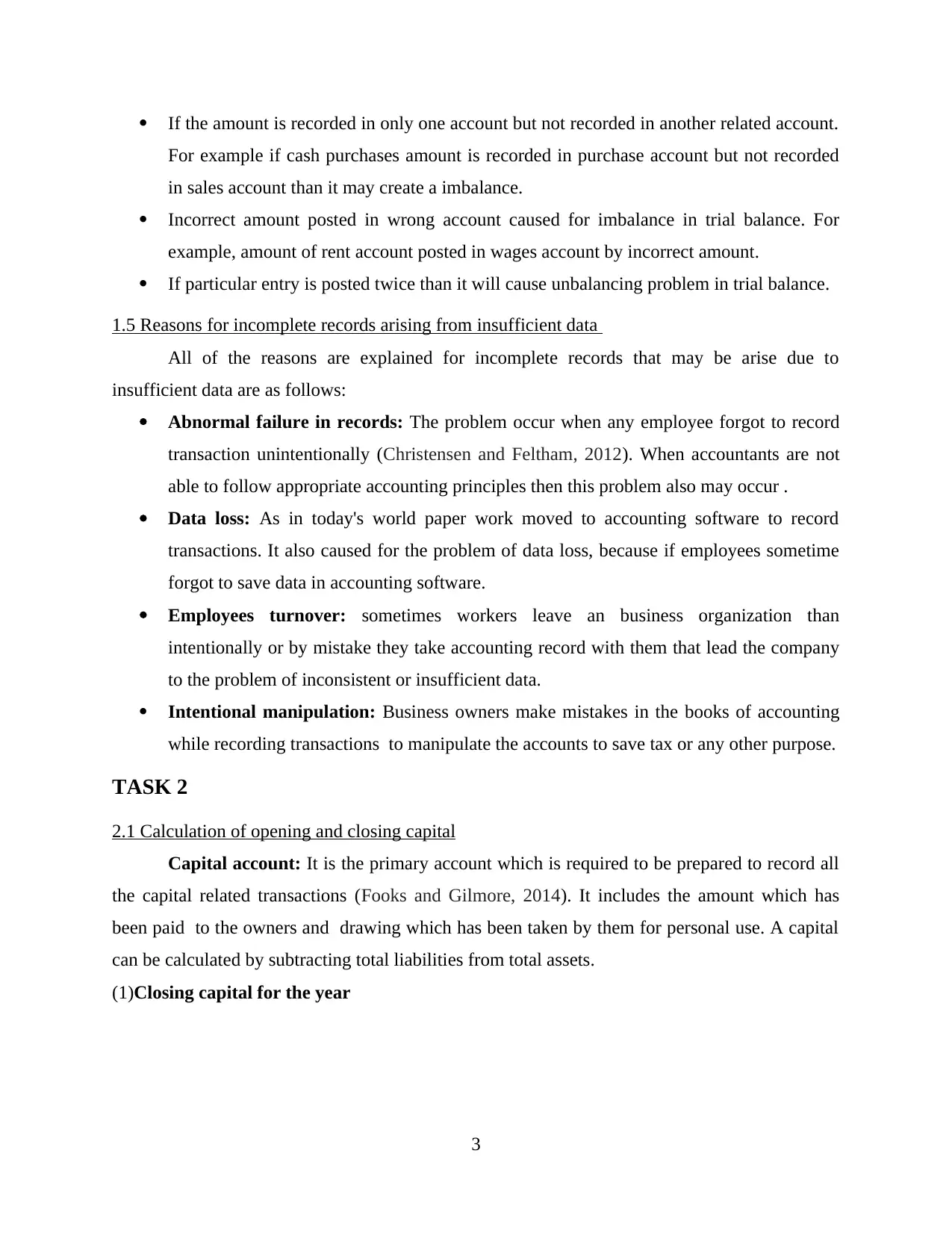
If the amount is recorded in only one account but not recorded in another related account.
For example if cash purchases amount is recorded in purchase account but not recorded
in sales account than it may create a imbalance.
Incorrect amount posted in wrong account caused for imbalance in trial balance. For
example, amount of rent account posted in wages account by incorrect amount.
If particular entry is posted twice than it will cause unbalancing problem in trial balance.
1.5 Reasons for incomplete records arising from insufficient data
All of the reasons are explained for incomplete records that may be arise due to
insufficient data are as follows:
Abnormal failure in records: The problem occur when any employee forgot to record
transaction unintentionally (Christensen and Feltham, 2012). When accountants are not
able to follow appropriate accounting principles then this problem also may occur .
Data loss: As in today's world paper work moved to accounting software to record
transactions. It also caused for the problem of data loss, because if employees sometime
forgot to save data in accounting software.
Employees turnover: sometimes workers leave an business organization than
intentionally or by mistake they take accounting record with them that lead the company
to the problem of inconsistent or insufficient data.
Intentional manipulation: Business owners make mistakes in the books of accounting
while recording transactions to manipulate the accounts to save tax or any other purpose.
TASK 2
2.1 Calculation of opening and closing capital
Capital account: It is the primary account which is required to be prepared to record all
the capital related transactions (Fooks and Gilmore, 2014). It includes the amount which has
been paid to the owners and drawing which has been taken by them for personal use. A capital
can be calculated by subtracting total liabilities from total assets.
(1)Closing capital for the year
3
For example if cash purchases amount is recorded in purchase account but not recorded
in sales account than it may create a imbalance.
Incorrect amount posted in wrong account caused for imbalance in trial balance. For
example, amount of rent account posted in wages account by incorrect amount.
If particular entry is posted twice than it will cause unbalancing problem in trial balance.
1.5 Reasons for incomplete records arising from insufficient data
All of the reasons are explained for incomplete records that may be arise due to
insufficient data are as follows:
Abnormal failure in records: The problem occur when any employee forgot to record
transaction unintentionally (Christensen and Feltham, 2012). When accountants are not
able to follow appropriate accounting principles then this problem also may occur .
Data loss: As in today's world paper work moved to accounting software to record
transactions. It also caused for the problem of data loss, because if employees sometime
forgot to save data in accounting software.
Employees turnover: sometimes workers leave an business organization than
intentionally or by mistake they take accounting record with them that lead the company
to the problem of inconsistent or insufficient data.
Intentional manipulation: Business owners make mistakes in the books of accounting
while recording transactions to manipulate the accounts to save tax or any other purpose.
TASK 2
2.1 Calculation of opening and closing capital
Capital account: It is the primary account which is required to be prepared to record all
the capital related transactions (Fooks and Gilmore, 2014). It includes the amount which has
been paid to the owners and drawing which has been taken by them for personal use. A capital
can be calculated by subtracting total liabilities from total assets.
(1)Closing capital for the year
3
⊘ This is a preview!⊘
Do you want full access?
Subscribe today to unlock all pages.

Trusted by 1+ million students worldwide
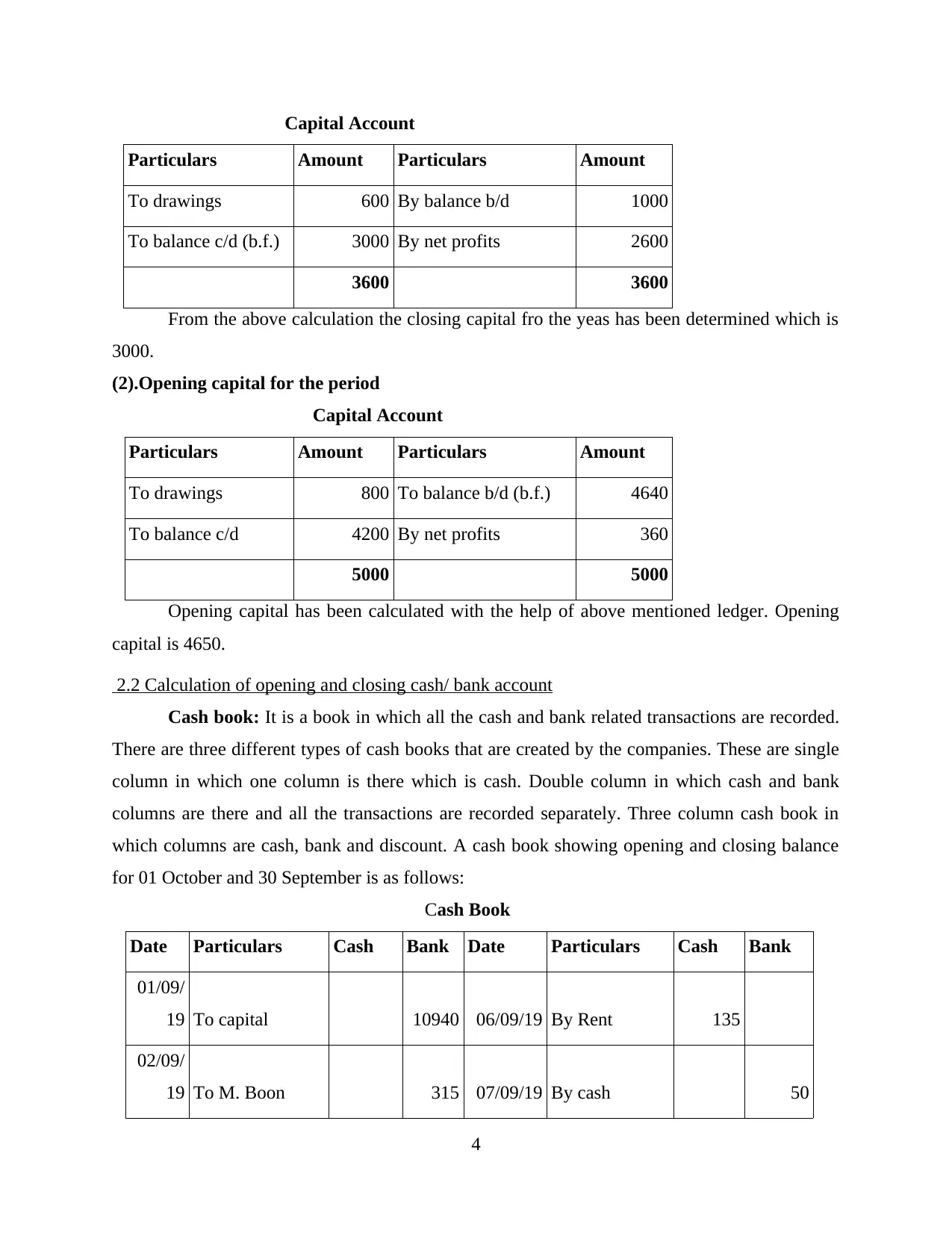
Capital Account
Particulars Amount Particulars Amount
To drawings 600 By balance b/d 1000
To balance c/d (b.f.) 3000 By net profits 2600
3600 3600
From the above calculation the closing capital fro the yeas has been determined which is
3000.
(2).Opening capital for the period
Capital Account
Particulars Amount Particulars Amount
To drawings 800 To balance b/d (b.f.) 4640
To balance c/d 4200 By net profits 360
5000 5000
Opening capital has been calculated with the help of above mentioned ledger. Opening
capital is 4650.
2.2 Calculation of opening and closing cash/ bank account
Cash book: It is a book in which all the cash and bank related transactions are recorded.
There are three different types of cash books that are created by the companies. These are single
column in which one column is there which is cash. Double column in which cash and bank
columns are there and all the transactions are recorded separately. Three column cash book in
which columns are cash, bank and discount. A cash book showing opening and closing balance
for 01 October and 30 September is as follows:
Cash Book
Date Particulars Cash Bank Date Particulars Cash Bank
01/09/
19 To capital 10940 06/09/19 By Rent 135
02/09/
19 To M. Boon 315 07/09/19 By cash 50
4
Particulars Amount Particulars Amount
To drawings 600 By balance b/d 1000
To balance c/d (b.f.) 3000 By net profits 2600
3600 3600
From the above calculation the closing capital fro the yeas has been determined which is
3000.
(2).Opening capital for the period
Capital Account
Particulars Amount Particulars Amount
To drawings 800 To balance b/d (b.f.) 4640
To balance c/d 4200 By net profits 360
5000 5000
Opening capital has been calculated with the help of above mentioned ledger. Opening
capital is 4650.
2.2 Calculation of opening and closing cash/ bank account
Cash book: It is a book in which all the cash and bank related transactions are recorded.
There are three different types of cash books that are created by the companies. These are single
column in which one column is there which is cash. Double column in which cash and bank
columns are there and all the transactions are recorded separately. Three column cash book in
which columns are cash, bank and discount. A cash book showing opening and closing balance
for 01 October and 30 September is as follows:
Cash Book
Date Particulars Cash Bank Date Particulars Cash Bank
01/09/
19 To capital 10940 06/09/19 By Rent 135
02/09/
19 To M. Boon 315 07/09/19 By cash 50
4
Paraphrase This Document
Need a fresh take? Get an instant paraphrase of this document with our AI Paraphraser
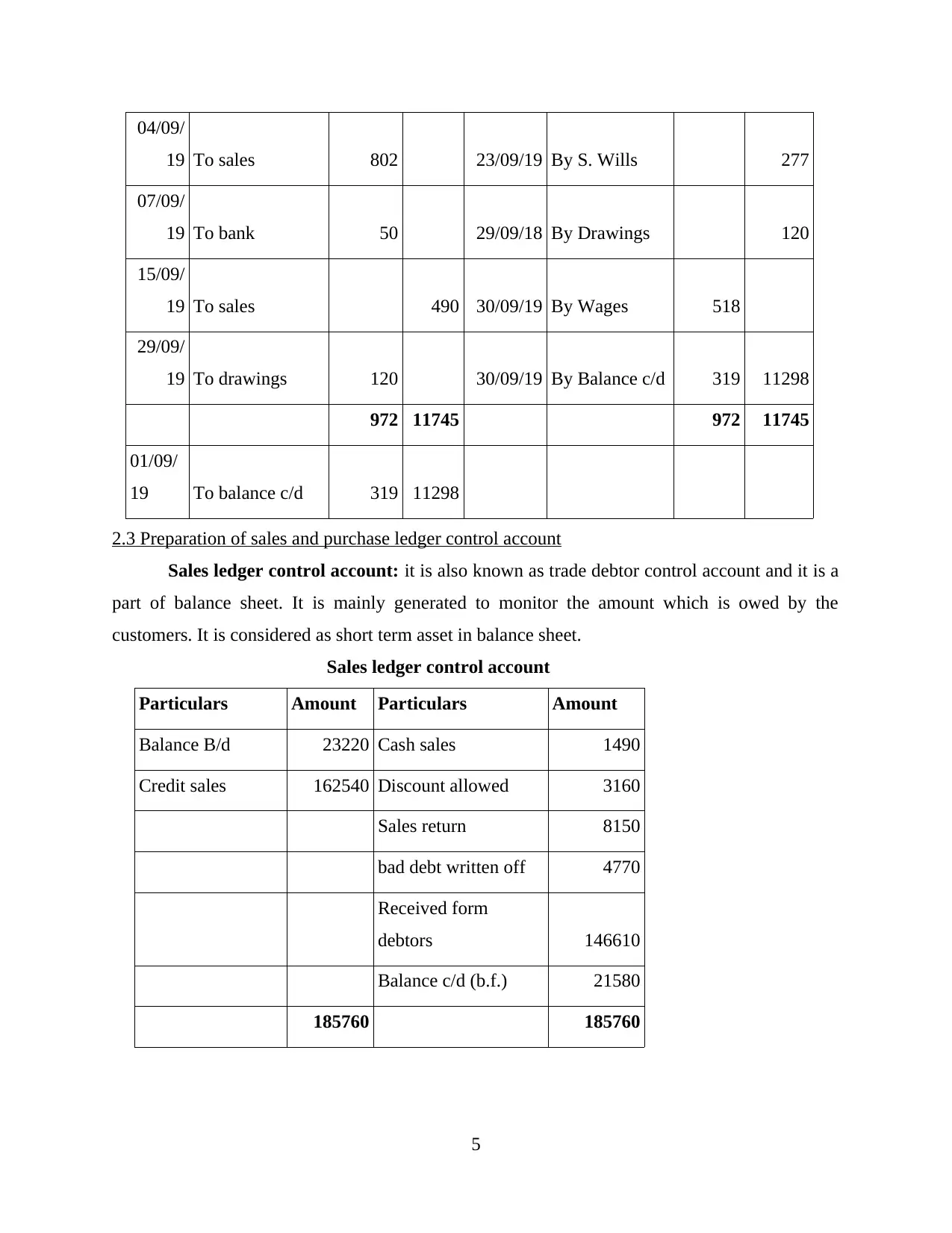
04/09/
19 To sales 802 23/09/19 By S. Wills 277
07/09/
19 To bank 50 29/09/18 By Drawings 120
15/09/
19 To sales 490 30/09/19 By Wages 518
29/09/
19 To drawings 120 30/09/19 By Balance c/d 319 11298
972 11745 972 11745
01/09/
19 To balance c/d 319 11298
2.3 Preparation of sales and purchase ledger control account
Sales ledger control account: it is also known as trade debtor control account and it is a
part of balance sheet. It is mainly generated to monitor the amount which is owed by the
customers. It is considered as short term asset in balance sheet.
Sales ledger control account
Particulars Amount Particulars Amount
Balance B/d 23220 Cash sales 1490
Credit sales 162540 Discount allowed 3160
Sales return 8150
bad debt written off 4770
Received form
debtors 146610
Balance c/d (b.f.) 21580
185760 185760
5
19 To sales 802 23/09/19 By S. Wills 277
07/09/
19 To bank 50 29/09/18 By Drawings 120
15/09/
19 To sales 490 30/09/19 By Wages 518
29/09/
19 To drawings 120 30/09/19 By Balance c/d 319 11298
972 11745 972 11745
01/09/
19 To balance c/d 319 11298
2.3 Preparation of sales and purchase ledger control account
Sales ledger control account: it is also known as trade debtor control account and it is a
part of balance sheet. It is mainly generated to monitor the amount which is owed by the
customers. It is considered as short term asset in balance sheet.
Sales ledger control account
Particulars Amount Particulars Amount
Balance B/d 23220 Cash sales 1490
Credit sales 162540 Discount allowed 3160
Sales return 8150
bad debt written off 4770
Received form
debtors 146610
Balance c/d (b.f.) 21580
185760 185760
5
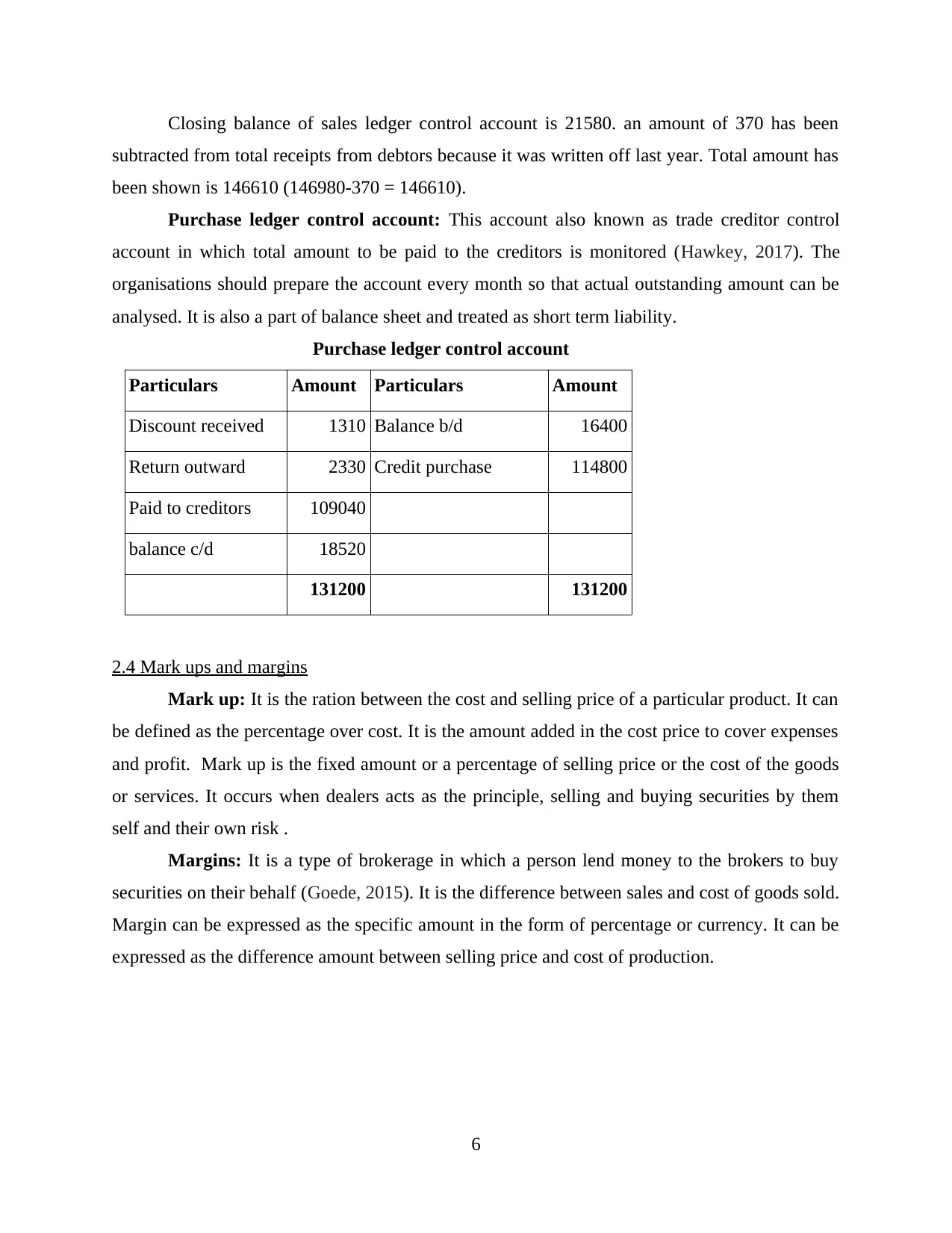
Closing balance of sales ledger control account is 21580. an amount of 370 has been
subtracted from total receipts from debtors because it was written off last year. Total amount has
been shown is 146610 (146980-370 = 146610).
Purchase ledger control account: This account also known as trade creditor control
account in which total amount to be paid to the creditors is monitored (Hawkey, 2017). The
organisations should prepare the account every month so that actual outstanding amount can be
analysed. It is also a part of balance sheet and treated as short term liability.
Purchase ledger control account
Particulars Amount Particulars Amount
Discount received 1310 Balance b/d 16400
Return outward 2330 Credit purchase 114800
Paid to creditors 109040
balance c/d 18520
131200 131200
2.4 Mark ups and margins
Mark up: It is the ration between the cost and selling price of a particular product. It can
be defined as the percentage over cost. It is the amount added in the cost price to cover expenses
and profit. Mark up is the fixed amount or a percentage of selling price or the cost of the goods
or services. It occurs when dealers acts as the principle, selling and buying securities by them
self and their own risk .
Margins: It is a type of brokerage in which a person lend money to the brokers to buy
securities on their behalf (Goede, 2015). It is the difference between sales and cost of goods sold.
Margin can be expressed as the specific amount in the form of percentage or currency. It can be
expressed as the difference amount between selling price and cost of production.
6
subtracted from total receipts from debtors because it was written off last year. Total amount has
been shown is 146610 (146980-370 = 146610).
Purchase ledger control account: This account also known as trade creditor control
account in which total amount to be paid to the creditors is monitored (Hawkey, 2017). The
organisations should prepare the account every month so that actual outstanding amount can be
analysed. It is also a part of balance sheet and treated as short term liability.
Purchase ledger control account
Particulars Amount Particulars Amount
Discount received 1310 Balance b/d 16400
Return outward 2330 Credit purchase 114800
Paid to creditors 109040
balance c/d 18520
131200 131200
2.4 Mark ups and margins
Mark up: It is the ration between the cost and selling price of a particular product. It can
be defined as the percentage over cost. It is the amount added in the cost price to cover expenses
and profit. Mark up is the fixed amount or a percentage of selling price or the cost of the goods
or services. It occurs when dealers acts as the principle, selling and buying securities by them
self and their own risk .
Margins: It is a type of brokerage in which a person lend money to the brokers to buy
securities on their behalf (Goede, 2015). It is the difference between sales and cost of goods sold.
Margin can be expressed as the specific amount in the form of percentage or currency. It can be
expressed as the difference amount between selling price and cost of production.
6
⊘ This is a preview!⊘
Do you want full access?
Subscribe today to unlock all pages.

Trusted by 1+ million students worldwide
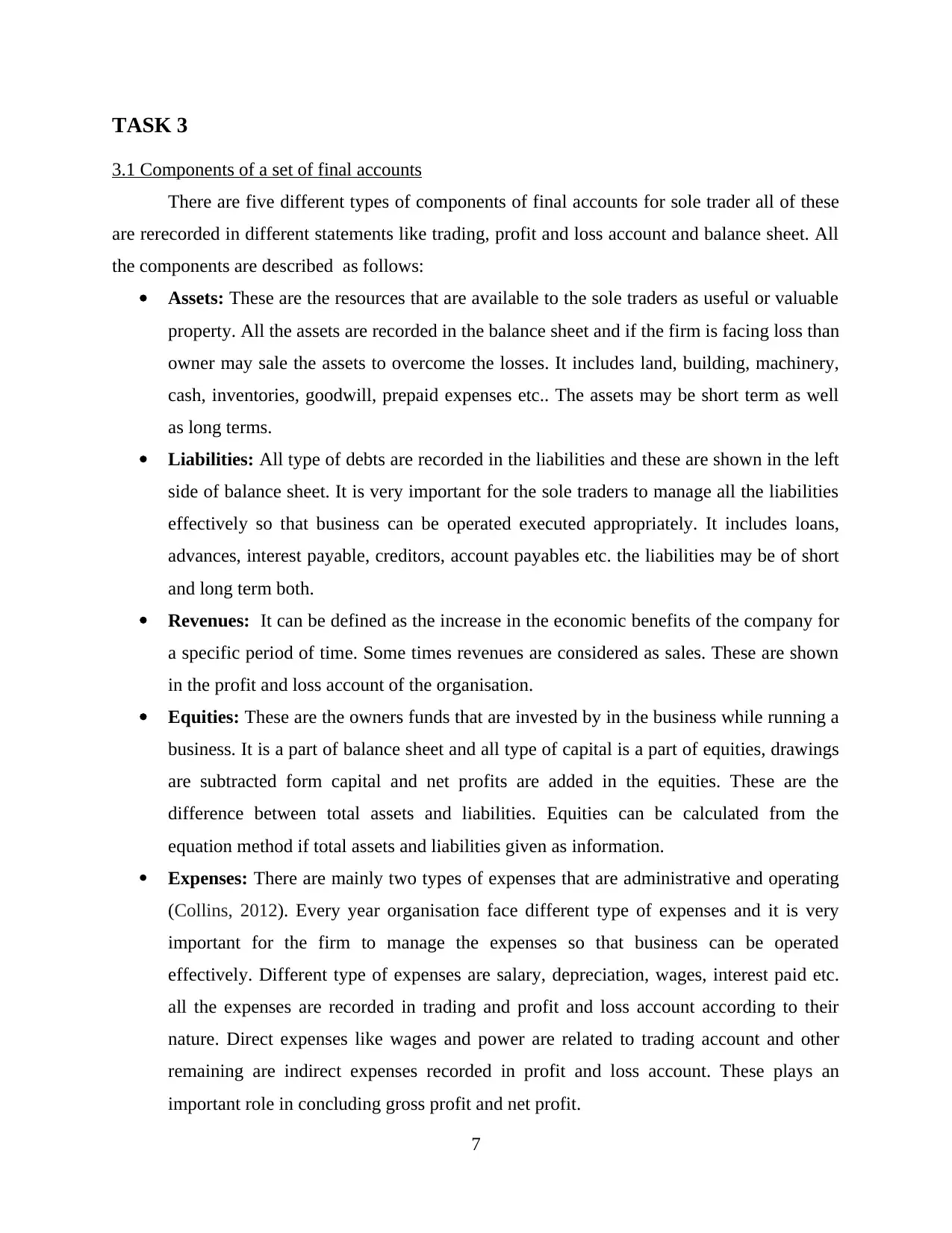
TASK 3
3.1 Components of a set of final accounts
There are five different types of components of final accounts for sole trader all of these
are rerecorded in different statements like trading, profit and loss account and balance sheet. All
the components are described as follows:
Assets: These are the resources that are available to the sole traders as useful or valuable
property. All the assets are recorded in the balance sheet and if the firm is facing loss than
owner may sale the assets to overcome the losses. It includes land, building, machinery,
cash, inventories, goodwill, prepaid expenses etc.. The assets may be short term as well
as long terms.
Liabilities: All type of debts are recorded in the liabilities and these are shown in the left
side of balance sheet. It is very important for the sole traders to manage all the liabilities
effectively so that business can be operated executed appropriately. It includes loans,
advances, interest payable, creditors, account payables etc. the liabilities may be of short
and long term both.
Revenues: It can be defined as the increase in the economic benefits of the company for
a specific period of time. Some times revenues are considered as sales. These are shown
in the profit and loss account of the organisation.
Equities: These are the owners funds that are invested by in the business while running a
business. It is a part of balance sheet and all type of capital is a part of equities, drawings
are subtracted form capital and net profits are added in the equities. These are the
difference between total assets and liabilities. Equities can be calculated from the
equation method if total assets and liabilities given as information.
Expenses: There are mainly two types of expenses that are administrative and operating
(Collins, 2012). Every year organisation face different type of expenses and it is very
important for the firm to manage the expenses so that business can be operated
effectively. Different type of expenses are salary, depreciation, wages, interest paid etc.
all the expenses are recorded in trading and profit and loss account according to their
nature. Direct expenses like wages and power are related to trading account and other
remaining are indirect expenses recorded in profit and loss account. These plays an
important role in concluding gross profit and net profit.
7
3.1 Components of a set of final accounts
There are five different types of components of final accounts for sole trader all of these
are rerecorded in different statements like trading, profit and loss account and balance sheet. All
the components are described as follows:
Assets: These are the resources that are available to the sole traders as useful or valuable
property. All the assets are recorded in the balance sheet and if the firm is facing loss than
owner may sale the assets to overcome the losses. It includes land, building, machinery,
cash, inventories, goodwill, prepaid expenses etc.. The assets may be short term as well
as long terms.
Liabilities: All type of debts are recorded in the liabilities and these are shown in the left
side of balance sheet. It is very important for the sole traders to manage all the liabilities
effectively so that business can be operated executed appropriately. It includes loans,
advances, interest payable, creditors, account payables etc. the liabilities may be of short
and long term both.
Revenues: It can be defined as the increase in the economic benefits of the company for
a specific period of time. Some times revenues are considered as sales. These are shown
in the profit and loss account of the organisation.
Equities: These are the owners funds that are invested by in the business while running a
business. It is a part of balance sheet and all type of capital is a part of equities, drawings
are subtracted form capital and net profits are added in the equities. These are the
difference between total assets and liabilities. Equities can be calculated from the
equation method if total assets and liabilities given as information.
Expenses: There are mainly two types of expenses that are administrative and operating
(Collins, 2012). Every year organisation face different type of expenses and it is very
important for the firm to manage the expenses so that business can be operated
effectively. Different type of expenses are salary, depreciation, wages, interest paid etc.
all the expenses are recorded in trading and profit and loss account according to their
nature. Direct expenses like wages and power are related to trading account and other
remaining are indirect expenses recorded in profit and loss account. These plays an
important role in concluding gross profit and net profit.
7
Paraphrase This Document
Need a fresh take? Get an instant paraphrase of this document with our AI Paraphraser
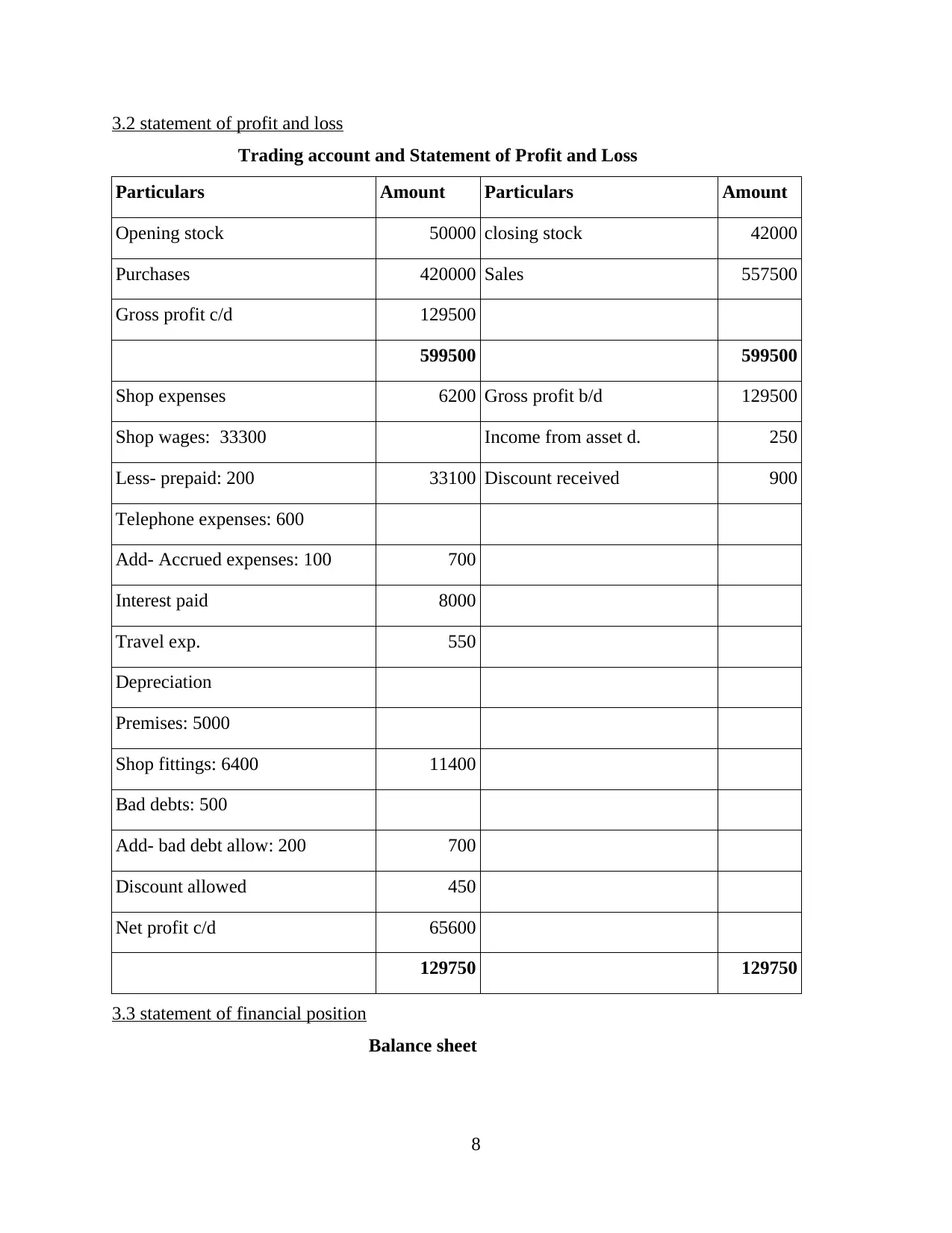
3.2 statement of profit and loss
Trading account and Statement of Profit and Loss
Particulars Amount Particulars Amount
Opening stock 50000 closing stock 42000
Purchases 420000 Sales 557500
Gross profit c/d 129500
599500 599500
Shop expenses 6200 Gross profit b/d 129500
Shop wages: 33300 Income from asset d. 250
Less- prepaid: 200 33100 Discount received 900
Telephone expenses: 600
Add- Accrued expenses: 100 700
Interest paid 8000
Travel exp. 550
Depreciation
Premises: 5000
Shop fittings: 6400 11400
Bad debts: 500
Add- bad debt allow: 200 700
Discount allowed 450
Net profit c/d 65600
129750 129750
3.3 statement of financial position
Balance sheet
8
Trading account and Statement of Profit and Loss
Particulars Amount Particulars Amount
Opening stock 50000 closing stock 42000
Purchases 420000 Sales 557500
Gross profit c/d 129500
599500 599500
Shop expenses 6200 Gross profit b/d 129500
Shop wages: 33300 Income from asset d. 250
Less- prepaid: 200 33100 Discount received 900
Telephone expenses: 600
Add- Accrued expenses: 100 700
Interest paid 8000
Travel exp. 550
Depreciation
Premises: 5000
Shop fittings: 6400 11400
Bad debts: 500
Add- bad debt allow: 200 700
Discount allowed 450
Net profit c/d 65600
129750 129750
3.3 statement of financial position
Balance sheet
8
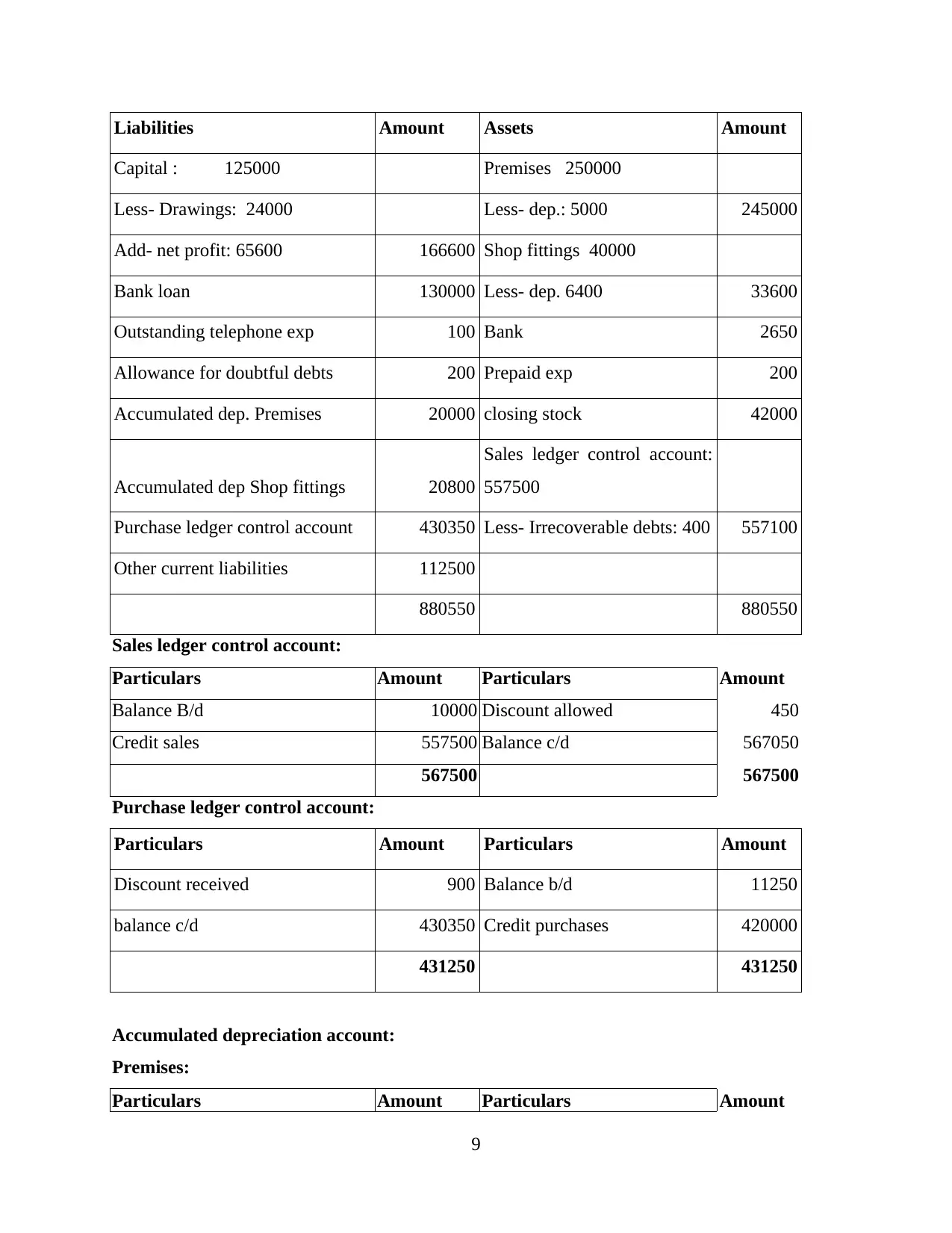
Liabilities Amount Assets Amount
Capital : 125000 Premises 250000
Less- Drawings: 24000 Less- dep.: 5000 245000
Add- net profit: 65600 166600 Shop fittings 40000
Bank loan 130000 Less- dep. 6400 33600
Outstanding telephone exp 100 Bank 2650
Allowance for doubtful debts 200 Prepaid exp 200
Accumulated dep. Premises 20000 closing stock 42000
Accumulated dep Shop fittings 20800
Sales ledger control account:
557500
Purchase ledger control account 430350 Less- Irrecoverable debts: 400 557100
Other current liabilities 112500
880550 880550
Sales ledger control account:
Particulars Amount Particulars Amount
Balance B/d 10000 Discount allowed 450
Credit sales 557500 Balance c/d 567050
567500 567500
Purchase ledger control account:
Particulars Amount Particulars Amount
Discount received 900 Balance b/d 11250
balance c/d 430350 Credit purchases 420000
431250 431250
Accumulated depreciation account:
Premises:
Particulars Amount Particulars Amount
9
Capital : 125000 Premises 250000
Less- Drawings: 24000 Less- dep.: 5000 245000
Add- net profit: 65600 166600 Shop fittings 40000
Bank loan 130000 Less- dep. 6400 33600
Outstanding telephone exp 100 Bank 2650
Allowance for doubtful debts 200 Prepaid exp 200
Accumulated dep. Premises 20000 closing stock 42000
Accumulated dep Shop fittings 20800
Sales ledger control account:
557500
Purchase ledger control account 430350 Less- Irrecoverable debts: 400 557100
Other current liabilities 112500
880550 880550
Sales ledger control account:
Particulars Amount Particulars Amount
Balance B/d 10000 Discount allowed 450
Credit sales 557500 Balance c/d 567050
567500 567500
Purchase ledger control account:
Particulars Amount Particulars Amount
Discount received 900 Balance b/d 11250
balance c/d 430350 Credit purchases 420000
431250 431250
Accumulated depreciation account:
Premises:
Particulars Amount Particulars Amount
9
⊘ This is a preview!⊘
Do you want full access?
Subscribe today to unlock all pages.

Trusted by 1+ million students worldwide
1 out of 17
Related Documents
Your All-in-One AI-Powered Toolkit for Academic Success.
+13062052269
info@desklib.com
Available 24*7 on WhatsApp / Email
![[object Object]](/_next/static/media/star-bottom.7253800d.svg)
Unlock your academic potential
Copyright © 2020–2025 A2Z Services. All Rights Reserved. Developed and managed by ZUCOL.





